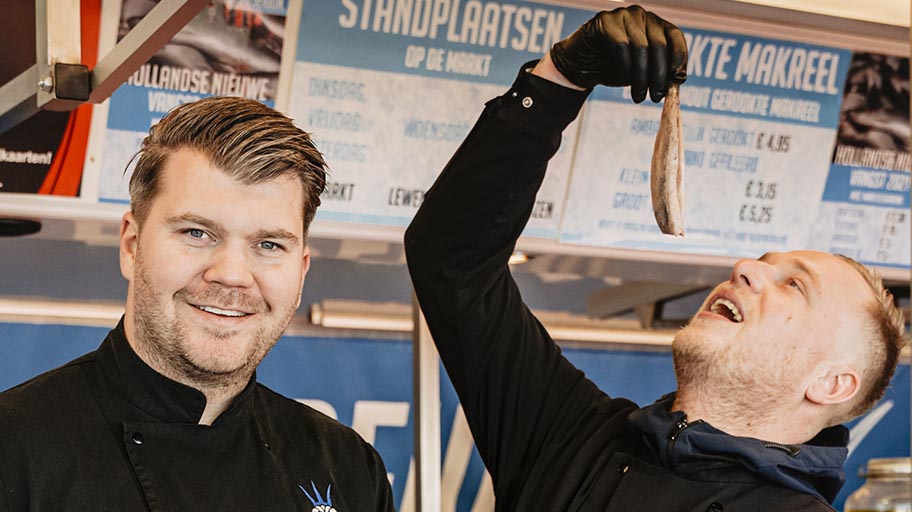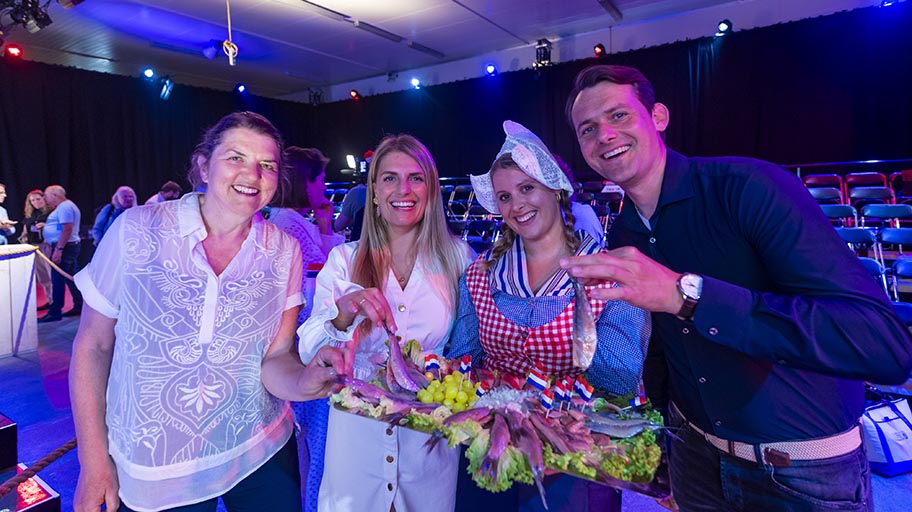 Fishmongers enjoying herring at Vismakelaar Poseidon, Groningen
Fishmongers enjoying herring at Vismakelaar Poseidon, Groningen
An anxious Dutch nation released a collective sigh of relief last month as the herring fishing season finally began, albeit a week late, on 23 June.
The short but essential delay allowed the fish to develop the crucial 16% fat required before they can be caught, cured, and turned into Hollandse Nieuwe, (new herring), one of the most popular Dutch dishes.
“We only start the herring season with good quality herring. Based on the development of the herring over the past few days, we know that the fat build-up is now more than sufficient to start processing into Hollandse Nieuwe,” said Gerbrand Voerman, recently retired chairman of the Dutch Haring Wholesale Association, the organisation responsible for deciding when the fishing seasons starts.
Herring has been an important part of the Dutch economy and way of life since the Middle Ages. To mark this, every June the Dutch celebrate the start of the herring fishing season by holding festivals all over the country with celebrities attending herring parties. Most people also try to eat herring the traditional way by holding the fish by the tail and sliding it down their throat.
Celebrations also include auctioning the first barrel of herring for charity. This year a bidding war between internet and energy company Budget Thuis and seafood retailer The FishLovers raised more than €159,000 (£140,000) for the Voedselbanken, a Dutch food bank.
 L-R: Christine Absil, (MSC), Jadis Schreuder (MSC Ambassador), herring server and Adriaan van Moort (Chairman, Association of Dutch Fishmongers) celebrating the Hollandse Nieuwe season.
L-R: Christine Absil, (MSC), Jadis Schreuder (MSC Ambassador), herring server and Adriaan van Moort (Chairman, Association of Dutch Fishmongers) celebrating the Hollandse Nieuwe season.
The MSC estimates that the Dutch consume more than 35 million sustainable herrings per year, but the consumption of herring in such quantities wasn’t always guaranteed. Without the introduction of sustainable fishing practices following the collapse of herring fish stocks from overfishing in the 1960s and 1970s, the outcome could have been very different.
Along with their Scottish counterparts, Dutch herring fisheries had to close for at least four years in the 1970s to allow stocks to recover. Many fisheries in both nations went bankrupt. There were 50 herring trawlers in the Dutch fleet at the time of the closure and only 12 when the ban was lifted.
These certifications helped bolster the industry and show critics it could be sustainable. Gerard van Balsfoort was then chairman of the Pelagic Freezer Trawler Association (PFA), an international association of large fishing companies. “The Dutch herring fishery adhered to the rules and yet we were portrayed as the symbol of overfishing. So the PFA turned to MSC. Obtaining the quality mark was the appropriate way for the herring fishermen to prove that they were working responsibly.”
Facts about Dutch herring
• About 50 billion herring swim in the North Sea every year.
• At a certain point during the Dutch Golden Age, the Netherlands had 80% of the herring market and made so much money from the herring trade that they were among the top three richest countries in Europe.
• The closing of the North Sea to herring fishing in 1977 forced some Dutch fishermen and herring buyers to move to some Scandinavian countries permanently. Denmark turned out to be the most suitable place for them.
• More than 80% of the herring eaten in the Netherlands isn’t caught there. Only two ships in the Netherlands are actively catching herring, in Scheveningen.
Also critical to success was the support received from Dutch and Belgian supermarkets, which committed to source 100% of their herring from MSC certified fisheries, making the Netherlands and Belgium the global forerunners for sustainable seafood.
“As a discounter, we have a lot of impact and therefore a huge responsibility. Moreover, we have to become more sustainable, otherwise there will soon be no more fish to sell,” says Ruth Broekaert, who is responsible for sustainability at ALDI in Belgium.
“Our partnership with [the] MSC and the choice of a reliable and independent label is fully in line with our core values: reliable, responsible, simple. A nice next step in the collaboration would be to focus even more on the pre-certification process via MSC; support[ing] fisheries that want to become more sustainable.”
The Dutch fishing industry has gone from strength to strength, with 58% of Dutch fisheries now certified sustainable.




